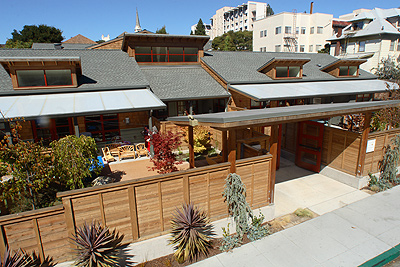Berkeleyan
 |
The first LEED-silver-certified child-care center in the state of California is the daytime home to 78 offspring of campus faculty, staff, and students. (Jonathan Martin/Capital Projects photo) |
Campus receives coveted ‘green’ certification for Haste Street child center
Facility provides an environmentally friendly framework for young Golden Bears, and makes protecting the planet a part of their daily lives
![]()
| 30 April 2008
The Haste Street Child Development Center, a two-story building three blocks from central campus, boasts formaldehyde-free furniture, fabric carpets that don’t off-gas harmful chemicals, “green” cleaning products, and recycling bins in daily use ... with worm bins for composting due to arrive soon. It’s not only the first campus building to receive LEED-silver certification for its environmental friendliness, but the first freestanding child-care center in the state to be so certified.
The approximately $6 million center serves 78 infant, toddler, and preschool offspring of Berkeley faculty, staff, and students, and also provides facilities for education, social welfare, and psychology researchers interested in child development.
The U.S. Green Building Council’s LEED Green Building rating system evaluates new and existing commercial, institutional, and high-rise residential buildings according to their environmental attributes and sustainable features. To earn a silver rating, a building must score 33 to 38 out of 69 possible points. The Haste Street center earned 38 points, one point short of the rare gold rating, says Chris Harvey, director of capital projects for Residential and Student Services Programs (RSSP).
Twenty percent of the center’s materials came from within 500 miles of the site, and 98 percent of the waste materials left over from construction were diverted from landfills and recycled. Paints, sealants, and other indoor materials were selected because of their minimal off-gassing of indoor air pollutants; housekeeping supplies are free of toxic chemicals; and stormwater runoff was reduced by 25 percent compared to the runoff from the site’s previous use as a parking lot. The center’s system of fluorescent lights, photocells for lighting circuits, radiant heat in concrete floors, and on-demand water heating enable the facility to exceed California’s mandated energy-efficiency standards by 40 percent.
“This center shows that our campus is serious about being socially responsible and responsive to the community,” says Laura Keeley-Saldana, RSSP director of early childhood education. “Families, as well as the community, have been very excited about our movement in this direction.”
While the UC system has incorporated expectations for LEED equivalency into all of its major capital projects, it does not mandate that each project undergo a formal and often expensive certification process that can cost thousands of dollars.
Says Capital Projects project manager Sally McGarrahan, who oversaw the child-care center’s planning and construction: “Certification has to be a priority from the beginning of the process and has to guide your design decisions throughout. If you start thinking about it after some fundamental site and system questions are already determined, it will be almost impossible to achieve enough credits.”
The campus’s next LEED-silver certification will be at University Village in Albany, where 324 units of replacement student-family housing will be completed in July. New student residences at Unit 1 on Durant Avenue and Unit 2 on Haste Street opened in 2005 and received recognition for LEED-silver equivalence.
More information about campus sustainability efforts is online at sustainability.berkeley.edu. The Green Building Research Center (greenbuildings.berkeley.edu) has been established on campus to promote sustainable-building design at Berkeley and other California universities.

